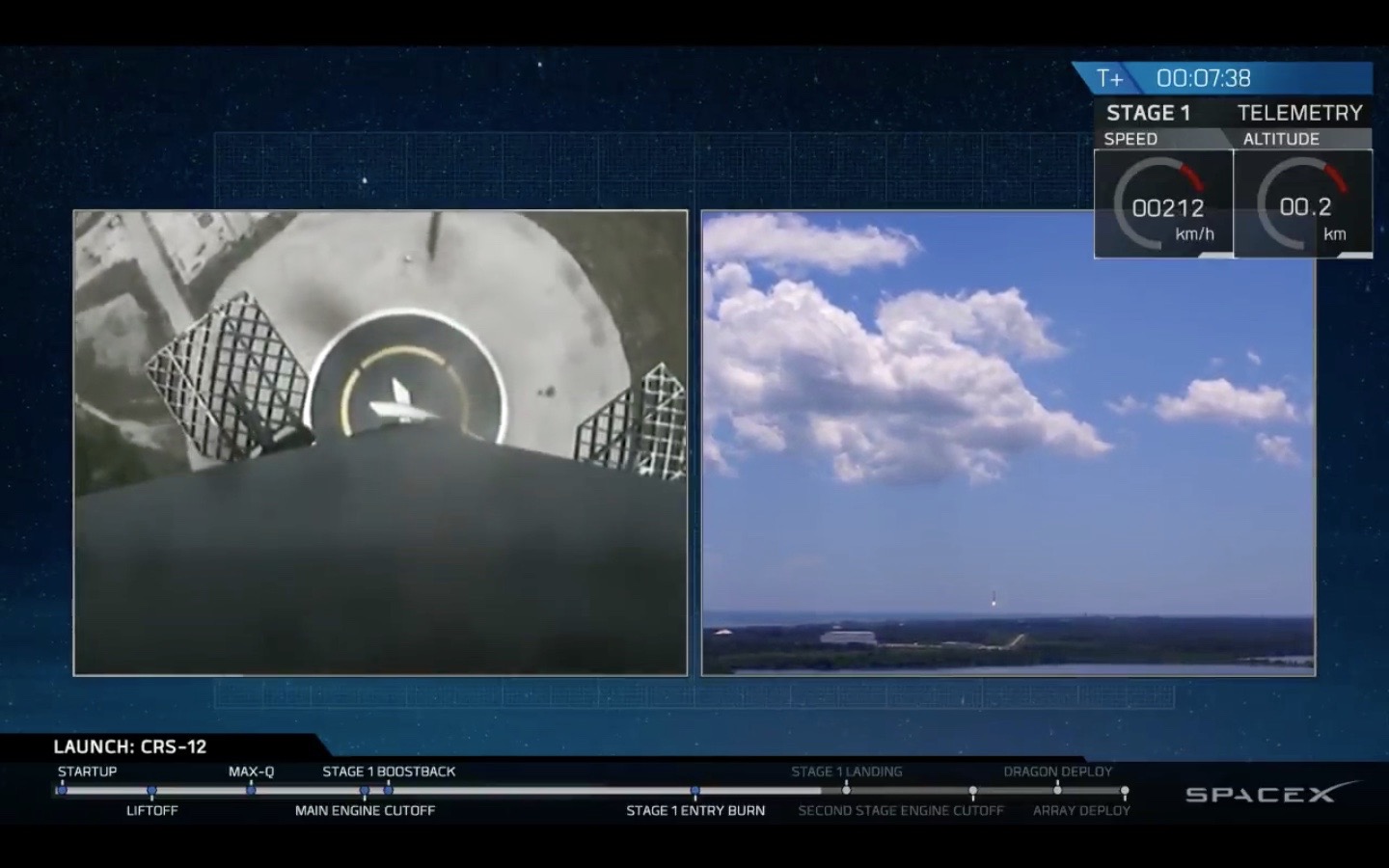SpaceX Launches NASA Cargo to Space Station, Sticks Rocket Landing (Again)
SpaceX has pulled off another one-two spaceflight punch.
One of the company's Falcon 9 rockets lifted off from historic Pad 39A at NASA's Kennedy Space Center (KSC) in Florida today (Aug. 14) at 12:31 p.m. EDT (1631 GMT), sending a robotic Dragon cargo capsule on its way to the International Space Station (ISS) for NASA.
Then, about 8 minutes after launch, the first stage of the two-stage Falcon 9 came back to Earth, touching down at SpaceX's "Landing Zone 1" at Cape Canaveral Air Force Station, which sits next door to KSC. [Inside SpaceX's Dragon Cargo Capsule (Infographic)]
SpaceX now has 14 such rocket landings under its belt, and the company has reflown two landed boosters to date. Such activities are part of SpaceX's effort to develop fully and rapidly reusable systems, which company founder and CEO Elon Musk has said could cut the cost of spaceflight dramatically.
Indeed, the company has also launched a pre-flown Dragon capsule on one occasion — the company's previous ISS cargo mission, which lifted off on June 3. (The Dragon that left Earth today is brand-new, but SpaceX plans to employ used capsules for the rest of its resupply flights, company representatives have said.)
If all goes according to plan, Dragon will chase the orbiting lab for two days, finally catching up to the station around 5:30 a.m. EDT (0930 GMT) on Wednesday (Aug. 16).
At that point, astronauts will grapple Dragon using the station's huge robotic arm, securing the freighter. When the hatches between the two vehicles open, ISS crewmembers will begin offloading the capsule's cargo, which consists of more than 6,400 lbs. (2,900 kilograms) of food, supplies and scientific hardware. (A lot of research gear is flying up on the Dragon, including seeded plant "pillows" for growth experiments and mice whose experience in microgravity should help researchers better understand the physiological impacts of long-duration spaceflight.)
Breaking space news, the latest updates on rocket launches, skywatching events and more!
The capsule is also carrying up some ice cream for the astronauts, NASA officials said.
"I think the crew is aware that there are some frozen treats on this particular mission, so I wouldn't be surprised if they work long in the day and try to open the hatch and enjoy some," Dan Hartman, deputy ISS Program manager at NASA's Johnson Space Center in Houston, at a pre-launch briefing yesterday (Aug. 13).
Dragon will spend about a month attached to the orbiting lab before heading back down to Earth for an ocean splashdown. SpaceX personnel will then retrieve the craft by boat.
Today's launch kicked off SpaceX's 12thcontracted resupply mission to the station for NASA. All of these flights have been successful except one; on June 28, 2015, a Falcon 9 broke apart less than 3 minutes after liftoff, scuttling a Dragon flight.
NASA also holds an ISS resupply contract with another American spaceflight company, Orbital ATK. The space agency has also contracted with SpaceX and Boeing to fly astronauts to and from the orbiting lab. These crewed missions — which will employ a crewed version of Dragon, as well as Boeing's CST-100 Starliner capsule — are currently scheduled to begin next year.
NASA has relied on Russian Soyuz spacecraft to ferry the agency's astronauts to and from the ISS since the space shuttle program ended in 2011.
Follow Mike Wall on Twitter @michaeldwall and Google+. Follow us @Spacedotcom, Facebook or Google+. Originally published on Space.com.

Michael Wall is a Senior Space Writer with Space.com and joined the team in 2010. He primarily covers exoplanets, spaceflight and military space, but has been known to dabble in the space art beat. His book about the search for alien life, "Out There," was published on Nov. 13, 2018. Before becoming a science writer, Michael worked as a herpetologist and wildlife biologist. He has a Ph.D. in evolutionary biology from the University of Sydney, Australia, a bachelor's degree from the University of Arizona, and a graduate certificate in science writing from the University of California, Santa Cruz. To find out what his latest project is, you can follow Michael on Twitter.

